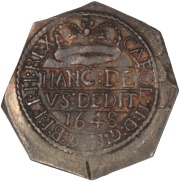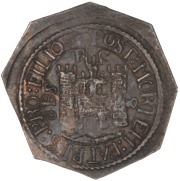 The 1648 Shilling - Charles I (Pontefract Siege)
The 1648 Shilling - Charles I (Pontefract Siege)Silver octagonal-shaped one Shilling siege coin struck at the Pontefract mint in 1648. It was actually struck after the death of Charles I on 30 January 1648 and so it was issued in the name of Charles II (Carol II on coin), although Charles II did not take the throne until 1660. Some class the coin as Charles II but Spinks list it under Charles I.
As the Civil War raged through England, coins were minted at many towns around the country to satisfy the need to create coins to pay soldiers and other costs of war. The coin is octagonal in shape (it is not clipped!). SCBC: 3151, North: 2649. Coins of this era tend to be quite expensive.
Width is 32mm and weighs 4.5g.
The Obverse shows a crown with three lines of test below: "HANC DE / VS DEDIT / 1648" (meaning God has given this 1648). Legend is "CAROL II D G MAG B F ET H REX".
The edge is plain.
 The Reverse shows a castle. On the right of the castle a canon protrudes. On the left is "OBS". Above centre turret is "PC". Legend is "POST MORTEM PATRIIS PRO FILIO" (meaning after the death of the father for the son).
The Reverse shows a castle. On the right of the castle a canon protrudes. On the left is "OBS". Above centre turret is "PC". Legend is "POST MORTEM PATRIIS PRO FILIO" (meaning after the death of the father for the son).Image credit: Museums Victoria
Mintage: Rare
Minted at The Royal Mint
More information (monarch, year, mint, country, category) can be found below coin listings.
Below are some coins currently being offered on eBay. As an eBay Partner, We may be compensated if you make a purchase.
List items on:
 | Very Rare 1648 Charles I Pontefract Besieged Shilling 1/- Coin £ 3,750.00 |
List items on:
Charles I (1625-1649)
 Charles I was born on 19 November 1600 and was King of England, King of Scotland, and King of Ireland from 27 March 1625 until his execution on 30 January 1649. He was in the House of Stuart.
Charles I was born on 19 November 1600 and was King of England, King of Scotland, and King of Ireland from 27 March 1625 until his execution on 30 January 1649. He was in the House of Stuart.From 1642, Charles fought in the English Civil War against the armies of the English and Scottish parliaments. After his defeat in 1645, Charles refused to accept his captors' demands for a constitutional monarchy. He escaped for a few years but was recaptured by Oliver Cromwell's New Model Army. He was tried for high treason and subsequently executed.
The monarchy was abolished and the Commonwealth of England became a republic. The monarchy would be restored in 1660 by Charles's son, Charles II.
The coinage of Charles I is one of the most interesting periods of English numismatic history. There are a huge amount of varieties and the coins include both hammered and early machine-made coins by Briot. Due to the Civil war many mints popped up around the country. It's a complex and involved subject featuring some outstanding coins. It probably takes an expert to identify a coin correctly.
Category: Shillings
The Shilling (written 1/-) is one-twentienth of a pound, worth 12 old pence (5 new pence). It is traditionally a silver coin, but since 1947 it has been made from cupro-nickel. Shillings are known as 'Bobs'.Shillings are old coins and the English shilling has been around since about 1549, although there were 12 pence coins before that called Testoons from about 1489. The British shillings was the continuation from 1707.
After decimalisation on 15 February 1971, the coin was replaced by the five new pence piece. Originally, the 5p coin was the same size as the shilling but was later made much smaller.
Which Mint: The Royal Mint
The Royal Mint is the designated place for the UK to mint coins. It dates back well over 1000 years and is a Government-owned company. Formed in the reign of Alfred the Great about the year 886, during the period 1279-1812 it was generally referred to as The Tower Mint as it was housed at the Tower of London. The Master of The Royal Mint has included famous figures such as Sir Isaac Newton.
Since 2010 it has operated as Royal Mint Ltd, a company owned by HM Treasury, under an exclusive contract to supply all coinage for the UK although it also produces medals and coins for other countries. It is currently located at Llantrisant, Wales.
Country of Origin: United Kingdom
The United Kingdom (UK) is the Union of England, Scotland, Wales and Northern Ireland. It is often refered to as Great Britain (GBR). It has a long, rich history. The orignal coinage was Pounds, Shillings and Pence but since decimalisation on 15 February 1971, it is £1 = 100p, that is One Pound = 100 pence. The coinage of the UK is also a long history, the Royal Mint being established as long ago as 886AD when coins were hammered. Today there is perhaps 30 billion coins in circulation, and many (numismatic) collectors coins and sets are issued frequently in gold, silver and other metals.
